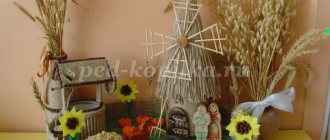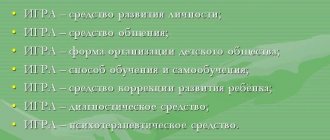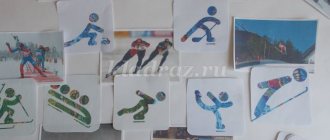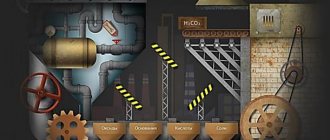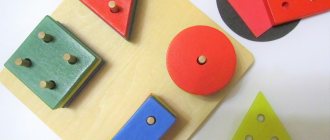by Alexey | For Kids Paper Crafts Other For Friends Gifts For Loved Ones Decor For Men For Women Origami Workshop Accessories | Sunday, March 30, 2014
| Follow Make-Self.net on Facebook and be the first to read our articles. |
What could be better than a handmade gift? Today we will tell you how to make a face with emotions using only cardboard and a few fasteners. With it, you can create dozens of emotions, thereby showing your mood or just for fun while spending time with your child.
How to create a face with emotions:
We will need six fasteners, cardboard (from any box), a knife, glue, a needle and thread.
Print out the TEMPLATE and place it on cardboard. If you use a BLANK TEMPLATE, decorate the details as you wish. Make holes where they are marked.
Insert the mount into your eyes, eyebrows, nose and mouth, then close it on the other side of your face.
Now we will glue our cheeks and tears onto the cardboard and secure them with threads, having previously made holes for them.
Voila!
Now you can create your own emotions with this cute cardboard face! What could be even simpler and more original?
You can also write emotions on cards and hang them below, as shown in the picture.
LiveInternetLiveInternet
Quote from Mamin_dnevnik message
Read in full In your quotation book or community!
Cards for activities with children - Emotions
Teach children to recognize emotions (joy, sadness, fear, anger) by facial expressions and intonation; depict these emotions using gestures, movements, and voice. Contribute to the enrichment of the emotional sphere Card index of games for the development of the emotional-volitional sphere in children 5-6 years old. “LET'S SAY HELLO” (from 5 years old) Purpose: the exercise continues acquaintance, creates a psychologically relaxed atmosphere. At the beginning of the exercise, we talk about different ways of greeting, real and comic. Children are invited to greet with their shoulder, back, hand, nose, cheek, come up with their own unusual way of greeting for today's lesson and say hello to them. (For each subsequent lesson, a new, previously unused way of greeting is invented! “STAND UP, ALL THOSE WHO ..." (from 5 years old) Purpose: the exercise is aimed at developing attention, observation, as well as continuing group acquaintance. The leader gives the task: “Stand up, everyone those who... - like to run, - enjoy good weather, - have a younger sister, - like to give flowers, etc. If desired, children can play the role of leader. After completing the exercise, children are asked questions summing up the game: - Now we’ll see , who in our group turned out to be the most attentive. Which of the guys remembered who in our group likes sweets? Who has a younger sister? Etc. Then the questions become more complicated (include two variables): - Who is in our group? group likes sweets and has a younger sister? Each question is addressed to a specific child, if he cannot answer himself, the group helps him" ————————————————————————— —————————————- No. 17 “DESCRIBE A FRIEND” (from 5 years old) Goal: development of attentiveness and the ability to describe what you saw, continuation of acquaintance. The exercise is performed in pairs (by all participants at the same time). Children stand with their backs to each other and take turns describing the hairstyle, clothes and face of their partner. Then the description is compared with the original and a conclusion is drawn about how accurate the child was. ——————————————————————————————————————— No. 18 “WHAT HAS CHANGED” (from 5 years old) Goal: development of attention and observation necessary for effective communication. Each child takes turns becoming a driver. The driver leaves the room. During this time, the group makes several changes in the children’s clothing and hairstyle; you can move to another place (but no more than two or three changes; all changes made must be visible). The driver’s task is to correctly notice the changes that have occurred. ________________________________________________________________________ No. 19 “HOW DO YOU FEEL?” (from 5 years old) Goal: development of attentiveness, empathy, the ability to feel the mood of another. The exercise is performed in a circle. Each child carefully looks at his neighbor on the left and tries to guess how he feels and talks about it. The child, whose condition is described, listens and then agrees with what was said or disagrees, complements. ——————————————————————————————————————— No. 20 “MY MOOD” (from 5 years old) Goal: developing the ability to describe one’s mood, recognize the moods of others, and develop empathy. Children are invited to tell others about their mood: you can draw it, you can compare it with some color, animal, state, you can show it in motion - it all depends on the child’s imagination and desire. ——————————————————————————————————————— No. 21 “A GIFT FOR EVERYONE (FLOWER - SEVEN-FLOWER) "(from 5 years old) Goal: development of a sense of team, the ability to make friends, make the right choice, cooperate with peers. The children are given the task: “If you were a wizard and could work miracles, what would you give to all of us now?” Or: “If we had a seven-flowered flower, what wish would you make?” Each child makes one wish by tearing one petal from a common flower. Fly, fly, petal, through the west to the east, through the north, through the south, come back, having made a circle, as soon as you touch the ground, be it in my opinion. Order that... At the end, you can hold a competition for the best wish for everyone. ——————————————————————————————————————— No. 22 “PORTRAIT OF THE BEST FRIEND” (from 5 years) Goal: development of analysis and self-analysis. Children are given the task of drawing a portrait of their best friend. Then a conversation is held: - Who do you consider your best, best friend? What qualities does this person have? Do you want to be considered a good friend? What should you do for this, how should you behave? During the general discussion, rules for joyful communication are formulated, which are drawn in a schematic form accessible to children or written down on a piece of Whatman paper in block letters (if the children already know how to read). For example: - Help your friends. - Share with them, learn to play and study together. - Stop your friend if he is doing something bad. Tell him if he's wrong about something. - Don’t quarrel, don’t argue over trifles; play together with everyone. - Do not envy. - If you did something bad, don’t be afraid to admit it, apologize. — Calmly accept the advice and help of other guys. - Don't be happy when someone loses. If you can, help him. - If you lose, don’t take your anger out on others, maybe you’ll win next time. _____________________________________________________________________________ No. 23 “ETUDE ON DIFFERENT POSITIONS IN COMMUNICATION” (from 5 years old) Goal: to get a feel for different positions in communication. Children are given the task to split into pairs. Communication in pairs takes place in a dialogue mode. Interesting and relevant topics for children are offered for communication: “My favorite animal”, “My happiest day last month”, etc. First, the communication situation is organized when both children sit facing each other, then one child sits on a chair, and the other stands near his chair (the children change places), then the children, sitting on the chair with their backs to each other, continue the conversation. Afterwards, the children are asked about the impressions and mood that arose during the communication process. How did you like to communicate? Why? ———————————————————————————————————————- No. 24 “HANDS ARE ACQUAINTING. HANDS ARE FIGHTING. HANDS MAKE PEACE” (from 5 years old) Goal: correlation of a person and his tactile image, removal of bodily barriers; developing the ability to express one’s feelings and understand the feelings of another through touch. The exercise is performed in pairs with eyes closed, children sit opposite each other at arm's length. An adult gives tasks (each task takes 2-3 minutes): - Close your eyes, stretch out your hands towards each other, introduce yourself with one hand. Try to get to know your neighbor better. Put your hands down” - Stretch your hands forward again, find your neighbor’s hands. Your hands are fighting. Put your hands down. - Your hands are looking for each other again. They want to make peace. Your hands make peace, they ask for forgiveness, you part as friends. Discuss how the exercise went, what feelings arose during the exercise, what did you like more? ——————————————————————————————————————— No. 25 “MAGIC TOOLS OF UNDERSTANDING” (from 5 years ) Introductory conversation. Goal: awareness that it is possible to help a person who is sad or ill, that everyone has the power to help everyone who needs it, understanding what exactly can be done for this. - What helps you when it’s difficult, bad, when you’ve done something wrong, when you’ve been offended? — What special things can people do with whom we enjoy communicating, what distinguishes them? (smile, ability to listen, eye contact, kind gentle voice, soft unsharp gestures, pleasant touches, polite words, ability to understand a person). — Why can we call these means of understanding “magical”? - Can you and I use these “magic” remedies when? ———————————————————————————————————————- No. 26 “FACES” (from 5 years old) Goal : Helps develop understanding of facial expressions and facial expressions. The leader hangs various pictures and masks on the board: - joy, - surprise, - interest, - anger, anger, - fear, - shame, - contempt, - disgust. The children’s task is to determine what feeling the mask expresses. ___________________________________________________________________________ No. 27 “MASKS” (from 5 years old) Goal: the ability to distinguish facial expressions, independently consciously use facial expressions to express your emotions. Each of the participants is given a task - to express grief, joy, pain, fear, surprise with the help of facial expressions... The remaining participants must determine what the participant was trying to portray. ______________________________________________________________________________ No. 28 “ROLE PLAYING SITUATIONS” (from 5 years old) Purpose: the exercise is performed in pairs, it is aimed at specific study, the use of “magic” means of understanding, the development of empathy, the use of already familiar means of understanding. Using the “magic” means of understanding, children must help: 1) a crying child who has lost his ball; 2) mom came home from work, she was very tired; 3) a friend in class is sitting sad, his mother is sick; 4) your friend is crying, he received a bad grade; 5) the girl next door asked you to make an applique for her... It is necessary to select so many situations so that each child can complete the task. ———————————————————————————————————————- No. 29 “DRAWING” (from 5 years old) Goal : development of empathy, creative imagination. The children are given the task: “Draw a kind animal and call it by an affectionate name, reward it with some magical means of understanding.” Drawing is carried out to the accompaniment of quiet, calm music, with paints or bright crayons, felt-tip pens on unlined white sheets. Then a competition is held for the kindest animal. The winner is awarded a certificate. ——————————————————————————————————————— No. 30 “ARTIST OF THE WORD” (from 5 years old) Goal : development of the ability to describe what is observed, the ability to highlight details essential for the description, the use of acceptable, non-offensive words, expansion of the active and passive vocabulary of children. Each child takes turns thinking of someone from the group and begins to draw his verbal portrait - his external characteristics (and, if possible, internal, psychological ones), without specifically naming this person’s name. Taking into account the level of development of children, you can offer them exercises on associative perception. (What animal does it look like? What flower? What piece of furniture? etc.) ————————————————————————————— —————————- No. 31 “LET’S MAKE A GIFT IN A CIRCLE FOR EACH OTHER” (from 5 years old) Goal: to develop in children a feeling for each other, an understanding of the other’s mood, the development of empathy. The presenter instructs everyone to give their neighbor on the right a gift, but not a specific gift, but a fictitious one: “What would you like to give to this particular person? Give the gift that you think he especially needs right now.” A gift can be described in words or shown with gestures. _________________________________________________________________________ No. 32 “TOY” (from 5 years old) Purpose: role-playing situations, practicing skills of effective interaction, empathy, and the ability to cooperate. The exercise is performed in pairs. One child from the couple is the owner of a beautiful and very beloved toy, which he loves to play with. Another child really wants to play with this toy. His task is to persuade the owner of the toy to let him play with it. Important: when performing this exercise, the child who owns the toy is given any toy that he should present as his favorite. As soon as the owner of the toy gives it to the asking child, the exercise is interrupted and the child is asked why he gave the toy.
